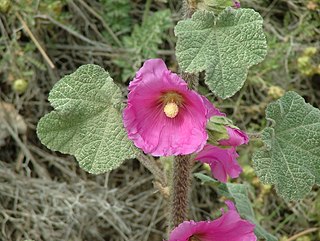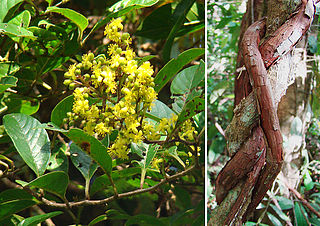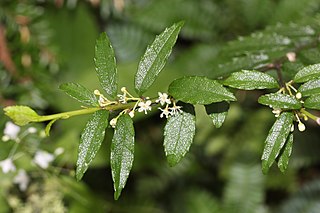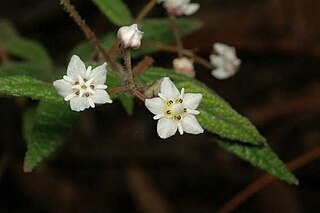
Rosa rugosa is a species of rose native to eastern Asia, in northeastern China, Japan, Korea and southeastern Siberia, where it grows on beach coasts, often on sand dunes. It is naturalized in much of Europe and parts of the United States and Canada. It should not be confused with Rosa multiflora, which is also known as "Japanese rose". The Latin word "rugosa" means "wrinkled", referring to the wrinkled leaves. Often used as an ornamental plant, it has become invasive in parts of Europe, North America and South America.

Alcea is a genus of over 80 species of flowering plants in the mallow family Malvaceae, commonly known as the hollyhocks. They are native to Asia and Europe. The single species of hollyhock from the Americas, the streambank wild hollyhock, belongs to a different genus.

Alcea rosea, the common hollyhock, is an ornamental dicot flowering plant in the family Malvaceae. It was imported into Europe from southwestern China during, or possibly before, the 15th century. William Turner, a herbalist of the time, gave it the name "holyoke" from which the English name derives.

Agastache rugosa, also known as wrinkled giant hyssop, Korean mint, purple giant hyssop, Indian mint and Chinese patchouli is an aromatic herb in the mint family, native to East Asia.

The Field Elm cultivar Ulmus minor 'Propendens', described by Schneider in 1904 as U. glabra (:minor) var. suberosa propendens, Weeping Cork-barked elm, was said by Krüssmann (1976) to be synonymous with the U. suberosa pendula listed by Lavallée without description in 1877. Earlier still, Loudon's Arboretum et Fruticetum Britannicum had included an illustration of a pendulous "cork-barked field elm", U. campestris suberosa. An U. campestris suberosa pendula was in nurseries by the 1870s.

Pseuduvaria is a genus of the plant family Annonaceae and tribe Miliuseae: with a native range is Tropical Asia.
The Field Elm cultivar Ulmus minor 'Rugosa' was distributed by the Späth nursery, Berlin, in the 1890s and early 1900s as U. campestris rugosaKirchner. Kirchner's tree, like Späth's a level-branched suberose field elm, was received from Belgium in 1864 as Ulmus rugosa pendula. Kirchner stressed that it was different from Loudon's Ulmus montana var. rugosa, being "more likely to belong to U. campestris or its subspecies, the Cork-elm".

Quercus rugosa, commonly known as the netleaf oak, is a broad-leaved tree in the beech and oak family Fagaceae. It is native to southern North America.

Solidago rugosa, commonly called the wrinkleleaf goldenrod or rough-stemmed goldenrod, is a species of flowering plant in the family Asteraceae. It is native to North America, where it is widespread across eastern and central Canada and the eastern and central United States. It is usually found in wet to mesic habitats.

Hakea rugosa, commonly known as wrinkled hakea or dwarf hakea, is a shrub of the family Proteaceae native to Australia. It has sharp needle-shaped leaves and white or cream fragrant flowers in profusion from August to October.

Alcea setosa, the bristly hollyhock, is an ornamental plant in the family Malvaceae.
Alcea tabrisiana is a species of flowering plant in the hollyhock genus Alcea, family Malvaceae. It is native to Turkey, the Transcaucasus, and Iran. It occurs on dry stony slopes, in mountain steppe and in forests, between 750 and 1,750 m elevation.

Malva tournefortiana is a species of flowering plant in the family Malvaceae, native to Morocco, Portugal, Spain and France. A hexaploid, it is in section Bismalva with M. moschata and M. alcea.

Davilla is a genus of flowering plants belonging to the family Dilleniaceae. It has around 30 neotropical, species and is one of the most diverse genera of lianas, vines, erect or scandent shrubs.

Olearia rugosa, commonly known as wrinkled daisy-bush, is a species of flowering plant in the family Asteraceae. It has alternate, wrinkled leaves and white daisy-like flowers and is endemic to south-eastern Australia.

Ilex rugosa, the tsuru holly, is a species of flowering plant in the family Aquifoliaceae, native to southern Khabarovsk Krai, Sakhalin, and the Kuril Islands in Russia, and to eight mountain summits in Japan. It is usually quite prostrate and does well in areas with protective winter snow cover to prevent damage from late frosts.

Rhynchospora rugosa, known by the common name of claybank beaksedge, is a member of the sedge family, Cyperaceae. It is a perennial herb, native to Central and South America.

Commersonia rugosa is a species of flowering plant in the family Malvaceae and endemic to New South Wales. It is an open, straggly shrub with linear to narrowly egg-shaped leaves with irregular teeth or lobes on the edges, and white flowers in clusters of 3 to 15.
Alcea heldreichii is a hollyhock plant native to southwestern Europe and Turkey.

Alcea striata, the desert hollyhock, is a tall hollyhock plant native between Turkey and Saudi Arabia. It is found in rocky limestone slopes, fields, roadsides, scrub, and deserts, in the elevations 0–1200 m. It can be found in Lebanon, Syria, Palestine, Saudi Arabia, Sinai, and Turkey.


















